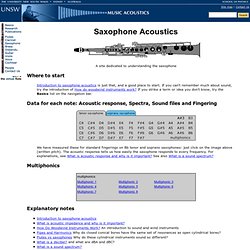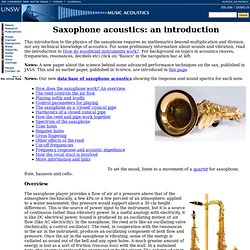

Jazz Standards Songs and Instrumentals Contents. How Do Woodwind Instruments Work? Something about sound The harmonic series The sound waves going up and down the instrument add up to give a standing wave, a vibration pattern of the air in the instrument.

Several different such patterns are possible. On a flute, with all keys down, you can play about seven or eight different notes. Their pitches (approximate) are given below. Eight harmonics of the lowest note on a flute. Harmonics and the different instrument bores Why can the air in the flute vibrate in these different ways? These graphs show the wave patterns in the three simplest air columns: open cylinder, closed cylinder and cone.
There is a more detailed discussion of standing waves in pipes in the introduction to flute acoustics, introduction to clarinet acoustics and introduction to saxophone acoustics, which also have a discussion of the use of register holes to produce harmonics. Flutes vs reed Instruments. Index. Saxophone acoustics. A site dedicated to understanding the saxophone Where to start Introduction to saxophone acoustics is just that, and a good place to start.

If you can't remember much about sound, try the introduction of How do woodwind instruments work? If you strike a term or idea you don't know, try the Basics list on the navigation bar. Data for each note: Acoustic response, Spectra, Sound files and Fingering We have measured these for standard fingerings on Bb tenor and soprano saxophones: just click on the image above (written pitch). Multiphonics Explanatory notes Introduction to saxophone acoustics What is acoustic impedance and why is it important?
This site includes research by Chen Jer Ming, a student completing his PhD in Music Acoustics, with contributions from Stefanie Orlik and Joe Wolfe. You can hear Sandy Evans play the tenor saxophone. Research and scholarship possibilities in music acoustics at UNSW. Introduction to saxophone acoustics. As we play more loudly, we increase the pressure (which moves the operating point to the right) and we also increase the range of pressure.

This means that the (larger) section of the curve we use is no longer approximately linear. This produces an asymmetric oscillation. It is no longer a sine wave, so its spectrum has more higher harmonics. (Centre diagram.) Have a look at the spectra for different dynamic levels on the note A#3. When we blow even harder, the valve closes for part of the part of the cycle when the pressure in the mouthpiece is low due to the standing wave inside the instrument. While talking about decibels, we should mention that spectra, including those on our saxophone site are usually shown on a decibel scale.
Soon after this page went up, saxophonists wanted to know a lot more about playing more loudly. Many examples of sound spectra are given on the data base. Control parametes for playing. New York's Grammy Award Winning Brass - Brass Basics. Click here to listen to our section and download clips Overview The focus of this column will be on horn sections, which frequently consist of a mix of brass and woodwind instruments.

Although there are many instruments in the brass family — including trumpet, cornet, trombone, French horn, euphonium, and tuba — I'll concentrate on trumpet and trombone and sax because they're the ones you'll most frequently encounter. When you will record in the studio 98.5% of the time the musicians will show up with: Bb Trumpet, Bb Flugelhorn (type of trumpet), Bb Tenor or Bass Symphonic or Jazz Trombone (with or without F valve), Eb Alto Sax, Bb Tenor Sax, Baritone Sax and Soprano Sax.
Here is a Short description of each instrument (Parts of these decsriptions were taken from wikipedia. Saxophone.org. Welcome to the Saxophone Buyer's Guide!

This project compiles over 20 years of experience spent buying and selling saxophones on a regional, national, and international basis. Over the course of these years, we've learned what to look for and how to find it. We've also learned what to watch out for and what some likely scenarios are for getting ripped off. As with any purchase, there are hazards in buying both new and used saxophones. However, by educating yourself and taking a common sense approach, these hazzards can easily be minimized.
This document is divided into sections that address the most frequently-asked questions about buying a saxophone. As part of this project, we must state that the information here is presented only as a representation of our personal experiences and opinions. This section is for people who might be purchasing a saxophone for the first time. This introduction to the physics of the saxophone requires no mathematics beyond.